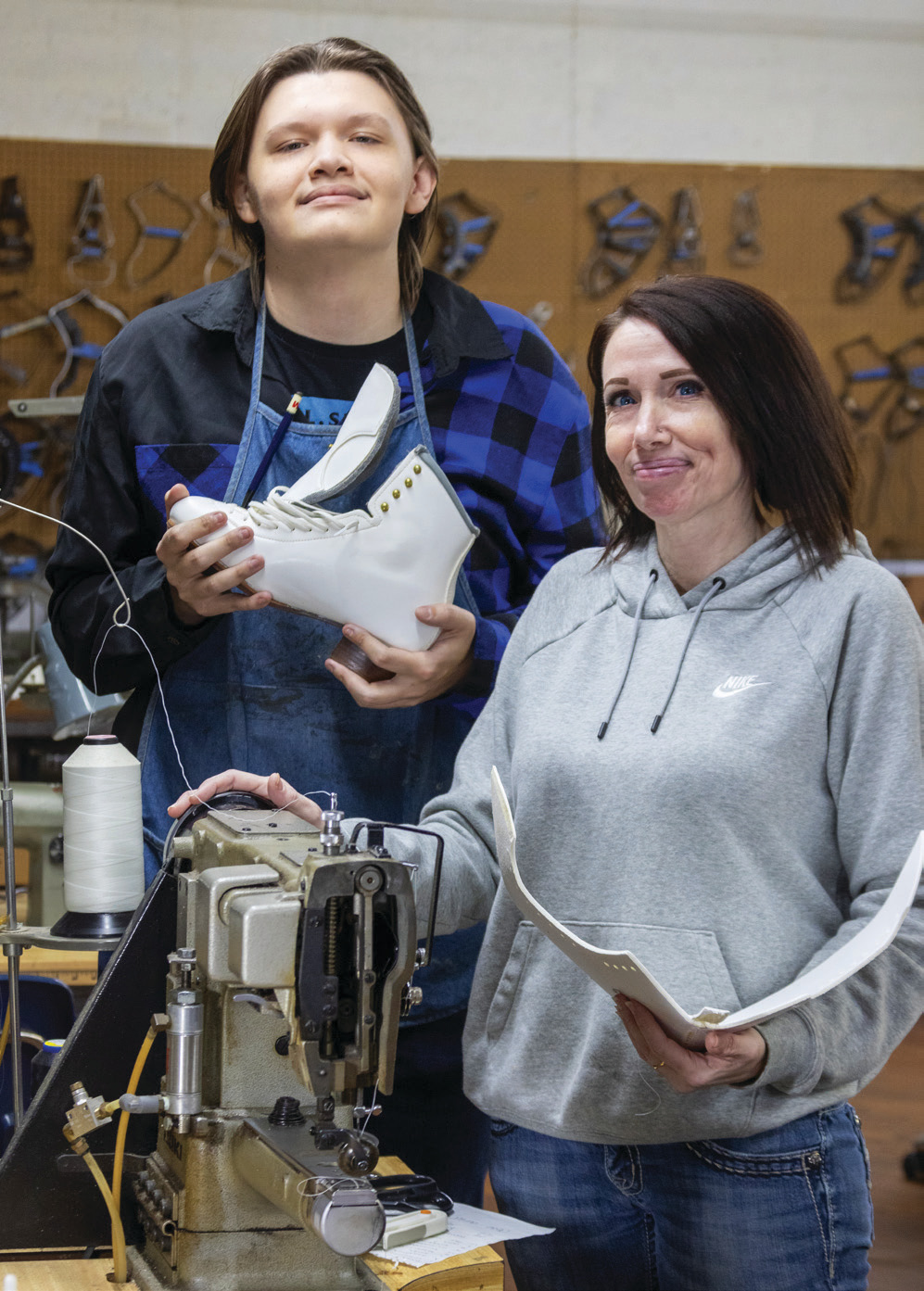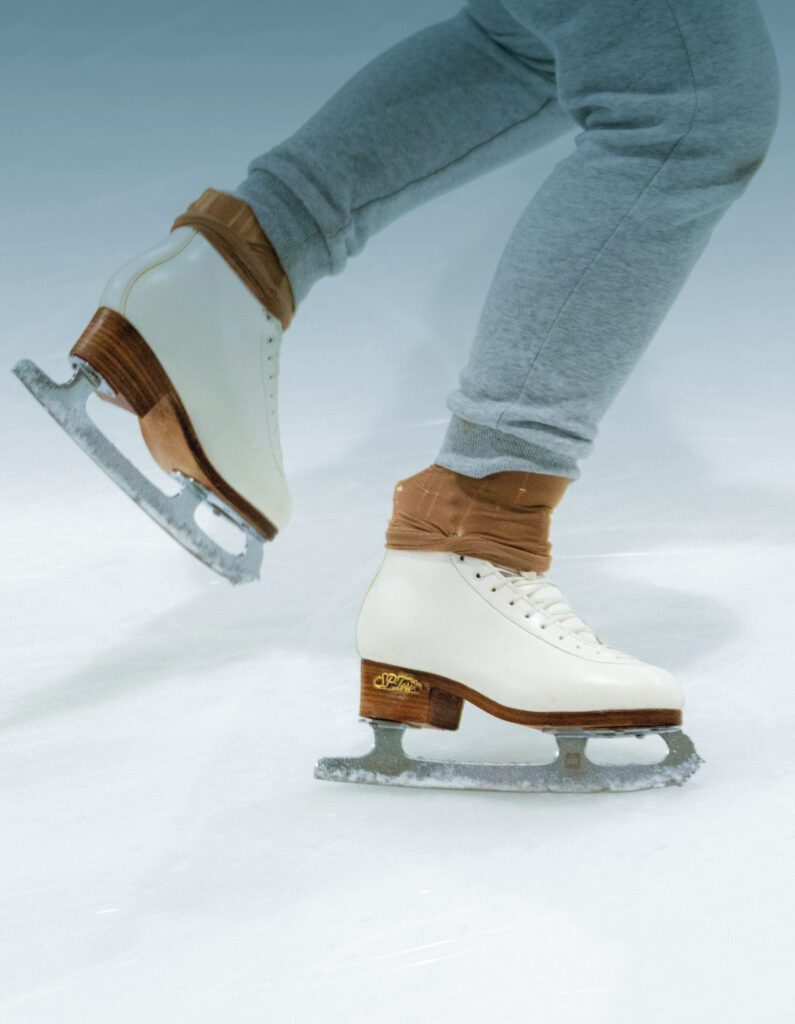Located at 55 High St. W. in McEwen, right by the town’s water tower and on Meriwether Lewis Electric Cooperative’s lines, sits a 30,000-square-foot factory building that has a rich history. Built after World War II in 1947, the factory was a major employer in Humphreys County for many years, employing up to 350 workers at a time and was home to Washington Manufacturing and then OshKosh B’gosh until 2000 when it became a warehouse and remained unchanged … until now.
The Little Factory in McEwen is the relatively new home of ice skating boot manufacturer SP-Teri, and Bill Fauver has big plans not only for SP-Teri but for the factory as well.
SP-Teri moved from California to Tennessee in 2019 when Bill took over leadership of the company as its president. He describes SP-Teri as a traditional, handcrafted ice skating boot maker. A lot of the company’s customers are amateur competitors, but even past Olympic skaters are in SP-Teri’s consumer base.
“If someone didn’t know about ice skating, they wouldn’t know about SP-Teri,” Bill said.
SP-Teri might not be pronounced how you would expect. It is pronounced “Ess-Spiteri” — the last part like the last name of the founder of the company, Joseph Spiteri. Joseph started SP-Teri in 1963. His son, George, is still an adviser for the company.
New leadership
With over 55 years of experience as a skater and coach, Bill has a long history with ice skating.
“I’ve been involved in figure skating for my entire life,” he said.
He competed in pairs skating at the Olympics in the 1970s and 1980s and then skated professionally with opportunities that took him all over the world. He now balances his work with SP-Teri in McEwen with teaching ice skating classes at Centennial Sportsplex in Nashville.

“It’s just all part of the package of me,” Bill said. “I teach skating; I can supply the boots; I can sharpen the skates. So, I have my niche in the skating community in Nashville.”
Bill has had to overcome many obstacles since he took over SP-Teri in fall 2019. A tornado hit the company’s first factory location in spring 2020, and the company had to move again after a second location was not a good fit for its manufacturing needs. Other obstacles SP-Teri has faced include the supply chain and demand issues that came with the COVID-19 pandemic.
And still, Bill and SP-Teri have persisted.
Personal
When asked if he could describe SP-Teri in one word, Bill said “personal.”
“It’s a very personal company because you’re working with people who are working with their fingers and their hands and their eyes,” Bill said. “We all know each other well by now, and it’s been remarkable to see how they’ve come along.”
He has a small staff of a few employees right now — Gary Fitzgerald, Deedra Llewellyn and Garrett Unger — and they all share a willingness to learn the skilled craft of making ice skates.
“Making skates is not like making anything else,” Bill said, adding that he is still learning even though he has been doing it for years now.
SP Teri’s ice skates are made-to-order. The small-scale manufacturing means that the skate-maker is able to fit each individual customer’s needs and customize the boot as needed. Along with the order, people send in detailed measurements, drawings of their foot sizes and shapes or even molds of their feet so each boot will be the perfect fit. Bill, Garrett and Deedra shared that they were once able to custom fit an ice skating boot to a boy’s prosthetic foot.
“They are handmade from the very beginning, so we put a lot of thought into them,” said Deedra, who specializes in the sewing department at SP-Teri. She is the third generation in her family to work in The Little Factory building in McEwen, and her son, Garrett, is the fourth generation.

The boot-making process usually starts with the material on the outside of the boot, which Deedra said could be many types of materials or colors. Leather or suede are the most typical materials for the boot, and black or white are the usual colors, but SP-Teri sometimes gets orders for scarlet-red ice skating boots, for example.

“We usually try to accommodate the customers on that customization, whatever they want; we had a blue jean pair recently,” Deedra said. “I really, personally, enjoy doing those. They’re just fun.”
High quality and traditional
“It’s just like cooking,” Bill said. “You have to have quality ingredients to start with.”
An SP-Teri ice skating boot is made with old-school craftsmanship: hand-sewn with soles made of leather.
“I’m a big proponent of an older style of manufacturing,” Bill said.
Bill said that a lot of new skates now are made of plastic that is meant to imitate leather and is manufactured by machines.
“Leather is probably one of the only materials that you can make any kind of shoe or boot with that has give and return,” Bill said. “The plastic skates have no return, no bend. They’re not meant to. They’re light, but they don’t really articulate.”
Ice skates made of leather will also last much longer; plastic ice skates are not meant to last.
Bill said that SP-Teri only makes high-quality ice skating boots.
“If somebody comes to us and says, ‘Can you make me a cheap boot?’ — I really can’t,” Bill said, “because we use the same leathers, the same hooks, the same laces, the same soles. The only varying part of it could be the type of material you want, how strong the boot is inside and the lining. Other than that, all the materials are the same.”
Deedra said there are more than 30 steps to making an SP-Teri ice skating boot (within the McEwen factory’s walls — when you don’t take into account the steps that were taken to produce the blades, laces or other components made by their suppliers).
Bill said that each step of the process requires skill and precision, explaining that “with each step, you can’t really vary the recipe.”

Tennessee-made
Bill bought the factory building in McEwen from the previous owners who were using it as a warehouse (he said he did not want to move SP-Teri a fourth time).
“It was dirty and dingy, the lights were shot and it had leaks in the roof,” Bill said. “But it’s like buying your first car. You don’t care!”
Bill has big dreams for The Little Factory: a rollerskating rink in the center of the large room (which, did we mention, SP-Teri hopes to make roller skates in the future?), vendors lining the sides, a restaurant and a farmer’s market and/or vendors outside the building. He is looking for a business partner to help with the expansion of the factory building. He hopes that this building is able to provide something special for the community of McEwen — a destination for people to come together. He also hopes the building helps increase brand visibility for SP-Teri.
A quick Google search into some of the biggest ice skating boot manufacturers around today shows that many are based out of East Asia. There is a handful of high-quality brands from Canada or Italy, and only a select few from the U.S. The other (few and far between) U.S. brands are based out of California and Minnesota; there’s only one in Tennessee: SP-Teri.
“I’m a big supporter on a very small scale of bringing manufacturing back to the States,” Bill said.
Bill has lived in Nashville for nearly 30 years, so he takes pride in the state that SP-Teri now calls home. His family lives and works in the ice skating scene in Nashville as well, and he has been (and continues to be) a part of multiple projects and programs related to ice skating and athletics in Nashville, one of note being CoachFax, which is a system for screening athletic coaches to keep young athletes safe.
In reflecting on his busy life full of ice skating, Bill said, “I just can’t see my life having gone any other direction. I don’t know how else to say that.”
In thinking about the opportunity that Bill gave her by hiring her to work for SP-Teri, Deedra said, “I never thought my dream would lead me here, but I’m glad it did.”
Deedra said her favorite part of making a pair of SP-Teri ice skating boots is when the employees are finished with the boots, adding that “they’re not complete until you’re actually finished.”
“When we put them in the box to ship, that’s my favorite part because then I can breathe and go on to the next pair.”




